Isaac Israëls
Isaac Lazarus Israëls (3 February 1865 – 7 October 1934) was a Dutch painter associated with the Amsterdam Impressionism movement.[2]
Isaac Israëls | |
|---|---|
 Isaac Israëls - Self-portrait with a painting of the Javanese prince Jodjana, oil on canvas, 1919[1] | |
| Born | Isaac Lazarus Israëls 3 February 1865 |
| Died | 7 October 1934 (aged 69) The Hague, Netherlands |
| Nationality | Dutch |
| Education | Royal Academy of Art Rijksakademie |
| Movement | Amsterdam Impressionism |
| Patron(s) | Jozef Israëls (father) |
| Olympic medal record | ||
|---|---|---|
| Art competitions | ||
| 1928 Amsterdam | Paintings | |
Biography
The son of Jozef Israëls, one of the most respected painters of the Hague School, and Aleida Schaap, Isaac Israëls displayed precocious artistic talent from an early age.
Between 1880 and 1882 he studied at the Royal Academy of Art, The Hague, where he met George Hendrik Breitner who was to become a lifelong friend. In 1881, when he was 16, he sold a painting, Bugle Practice, even before it was finished to the artist and collector Hendrik Willem Mesdag.[3] Two portraits he made in the same year of his grandmother and a family friend, Nannette Enthoven (below), attest to the technical ability he had attained by that age.[4][5] Starting in 1878, Israëls made annual visits to the Salon des Artistes Français with his father and in 1882 made his debut there with Military Burial.[6] In the 1885 Salon he received an honourable mention for his Transport of Colonial Soldiers.[7][8] At this time he was reading Émile Zola,[9] as was Breitner, and following his triumph at the Salon he spent a year travelling in the Belgian mining districts and elsewhere.
Beginning 1886, Israëls lived in Amsterdam and registered with Breitner at the Royal Academy of Visual Arts to complete his schooling. Both of them, however, quickly abandoned the academy for the more progressive circle of the Tachtigers, an influential group of writers and artists of the time. This was a group that insisted style must reflect content and that emotionally charged subjects can only be represented by an equally intense technique. Influenced by this philosophy, Israëls became a painter of the streets, cafes, and cabarets of Amsterdam. At this time he met the Dutch engraver and painter Willem de Zwart who also became a lifelong friend.
He often spent his summers with his father in the Dutch seaside resort of Scheveningen near The Hague. Guests included Édouard Manet and Max Liebermann. Interested by the changing light of sun and sea, he painted many colourful seaside scenes.
Towards the end of the century, Israëls was introduced by his childhood friend and portrait painter Thérèse Schwartze to the Amsterdam fashion house Hirsch & Cie at the Leidseplein. Israëls portrayed the whole range of the world of haute couture, from seamstress to wealthy client, gaining access even to the fitting-rooms.
Israëls moved to Paris in 1904, establishing his studio at 10 rue Alfred Stevens, 48.881784°N 2.338651°E, near Montmartre and just yards away from the studio of Henri de Toulouse-Lautrec whom he admired, as he also did Edgar Degas. As in Amsterdam, he painted the Parisian specific motifs: the public parks, cafes, cabarets and bistros, as well as such subjects as fairgrounds and circus acrobats. Likewise he sought out the fashion houses Paquin and Drecoll to continue his studies of the world of fashion. However, he only exhibited once in this period, in 1909.
At the outbreak of the First World War he was living in London, where he found new subjects in horse-riding at Rotten Row and in ballerinas and boxers. He returned to Holland for the duration of the war, living alternately in The Hague, Amsterdam and Scheveningen, where he worked primarily as a portrait painter. Amongst his sitters was Magaretha Gertrud Zelle, better known as Mata Hari, executed as a spy in France in 1917. Her portrait can be seen at the Kröller-Müller Museum. Other sitters included Johanna van Gogh-Bonger and the feminist physician Aletta Jacobs, although he also portrayed ordinary subjects such as girls in the street and telephone operators.
Following the war, Israëls visited Paris, Copenhagen, Stockholm and London. He spent the years 1921 to 1922 travelling in India and the Dutch East Indies, sketching and painting the vibrant life of South East Asia and notably the gamelan players of Bali. On his return, he settled at Koninginnegracht 2, The Hague, 52.085924°N 4.315014°E, his deceased parents' home, where he remained for the rest of his life, nevertheless making regular trips abroad to London, Italy and the French Riviera.
At the age of 63, he won a Gold Medal at the 1928 Olympic Games for his painting Red Rider,[10] an art competition then being part of the games.[11][12]
He died in The Hague on 7 October 1934, aged 69, as a result of a street accident a few days before. His partner at that time was Sophie de Vries.
Art market
On 26 April 2005, one of his Donkey riding on the Beach series realised €482,400 at Christie's, Amsterdam. The sale example[13] was almost identical to the one in the Rijksmuseum, Amsterdam (below),[14] but larger and a little more delicate in tone.[15][16]
On 24 October 2006, A table at the Restaurant Le Perroquet, Paris realised €493,600 at Christie's, Amsterdam.[17]
In July 2012 the City Archive of Amsterdam organized a solo exhibition to present Isaac Israëls's works in Amsterdam.[18]
Public collections
Among the public collections holding works by Isaac Israëls are:
- Museum de Fundatie, Zwolle, Netherlands
- Rijksmuseum Amsterdam
Gallery
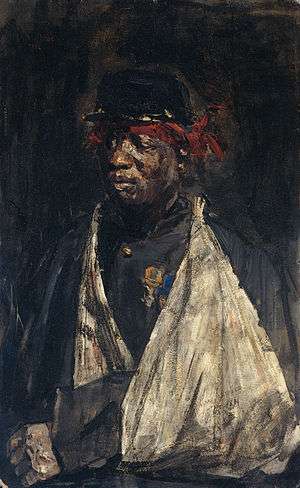
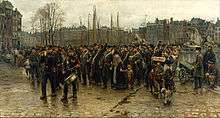
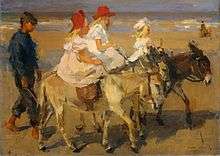
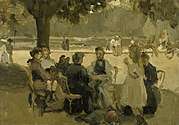 In the Bois de Boulogne close to Paris, oil on canvas, 1906
In the Bois de Boulogne close to Paris, oil on canvas, 1906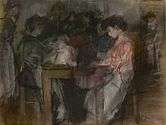 Seamstresses at Atelier Paquin, Paris, pencil and pastel on paper, ca. 1904
Seamstresses at Atelier Paquin, Paris, pencil and pastel on paper, ca. 1904_19e_eeuw.jpg) Reclining Nude, c. 1894-1900
Reclining Nude, c. 1894-1900
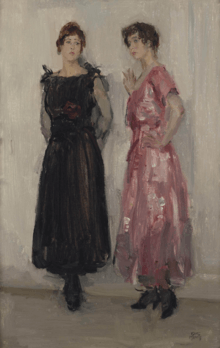 Ippy and Gertie Posing at Fashion House Hirsch, Amsterdam, ca. 1916
Ippy and Gertie Posing at Fashion House Hirsch, Amsterdam, ca. 1916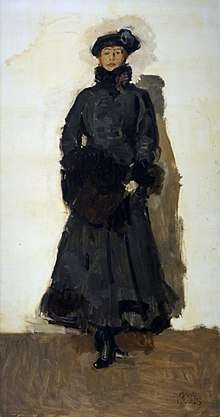 Painting of Mata Hari by Isaac Israëls, 1916
Painting of Mata Hari by Isaac Israëls, 1916- Woman before "Sunflowers" by Vincent van Gogh, ca. 1917, Museum de Fundatie, Zwolle[note 1][20][21][22]
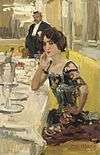 A table au Restaurant Le Perroquet, Paris, between 1905 and 1923
A table au Restaurant Le Perroquet, Paris, between 1905 and 1923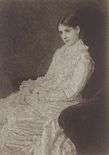 Portrait of Nanette Enthoven, oil on canvas, 1881[note 2]
Portrait of Nanette Enthoven, oil on canvas, 1881[note 2]
Notes
- Around 1917 Israëls borrowed a version of van Gogh's Sunflowers (the version now in the National Gallery, London) from Jo Bonger and used it as a backdrop for several of his portraits, of which this example and Homage to Van Gogh (Blue Blouse) are the best known. Isaac's father Josef was an important influence on van Gogh.
- Portrait of Nanette Enthoven (1852- before 1903), oil on canvas, 64 x 46 cm, 1881, an early work painted when Isaac was just 16 years old.
References
- "Isaac Israels and Raden Mas Jodjana: an East Indian friendship" (in Dutch). CODART. Retrieved 27 February 2019.
- "Israels, Isaäc Lazarus (1865-1934)" (in Dutch). Biografisch Woordenboek van Nederland:1880-2000.
- "Bugle Practice". Netherlands Institute for Art History.
- "Portrait of Mrs. Schaap-Hymans". Netherlands Institute for Art History.
- "Portrait of Nanette Enthoven". Netherlands Institute for Art History.
- "Military Burial". Netherlands Institute for Art History.
- "Transport of Colonial Soldiers". Kröller-Müller Museum, Otterlo.
- "Transport of Colonial Soldiers". Netherlands Institute for Art History.
- "Note 532, p.299". Van Gogh: The Life.
- "Isaac Israëls". Olympedia. Retrieved 23 July 2020.
- Heijmans, Jeroen. "The first two Gold Medals won by Holland in the 1928 Olympic Games were won not in the Olympic Stadium but in the Stedelijk Museum" (in Dutch). sportgeschiedenis.nl. Archived from the original on 8 May 2014. Retrieved 18 May 2012.
- "Rode rijder (Ing J.P. Leeuwenburg)". Netherlands Institute for Art History.
- "Ezeltje rijden op het strand". Netherlands Institute for Art History.
- "Ezeltje rijden op het strand (Rijksmuseum)". Netherlands Institute for Art History.
- "Sale 2659 / Lot 179: Isaac Israels - Ezeltje rijden: a donkey-ride on the beach". Christie's, Amsterdam.
- "Ezeltje rijden langs het strand". Rijksmuseum, Amsterdam. Archived from the original on 22 February 2005. Retrieved 13 May 2012.
- "Sale 2716 / Lot 220 : Isaac Israels - A table au Restaurant Le Perroquet, Paris". Christie's, Amsterdam.
- "Seven Photos of Isaac Israels Paintings Exhibition in Amsterdam". Amsterdam: Persiandutch.com. Archived from the original on 31 July 2012. Retrieved 31 July 2012.
- "Transport of colonial soldiers - Isaac Israels - Google Cultural Institute". googleartproject.com.
- Bohm-Duchen, Monica (2002). The Private Life of a Masterpiece: Uncovering the Forgotten Secrets and Hidden Life Histories of Iconic Works of Art. University of California Press. p. 126. ISBN 978-0520233782.
- "Vrouw en profil voor 'Zonnenbloemen' van Van Gogh". Netherlands Institute for Art History.
- ""Hommage aan Van Gogh" (blauwe blouse)". Netherlands Institute for Art History.
External links
| Wikimedia Commons has media related to Isaac Israëls. |